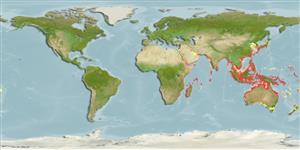Élasmobranches (requins et raies) (sharks and rays) >
Myliobatiformes (Stingrays) >
Dasyatidae (Stingrays) > Dasyatinae
Etymology: Telatrygon: Name from Latin 'telum' for javelin, spear, arrow, dart and Greek 'trygon' for stingray; referring to the long, narrowly pointed snout possessed by all members of the genus.
Eponymy: This species’ binomial zugei is after zugu-ei, the Japanese name for this species. (Ref. 128868), visit book page.
More on authors: Müller & Henle.
Environment: milieu / climate zone / profondeur / distribution range
Écologie
marin; saumâtre démersal; amphidrome (Ref. 51243)(Ref. 114953). Tropical
Northwest Pacific: Vietnam to Japan, probably in the Philipinnes and Thailand.
Length at first maturity / Taille / Poids / Âge
Maturité: Lm 18.7, range 19 - ? cm
Max length : 29.0 cm WD mâle / non sexé; (Ref. 109651)
Feed on bottom-dwelling organisms (Ref.50449); primarily small crustaceans, but also small fishes (Ref.58048). Ovoviviparous (Ref. 50449).
Life cycle and mating behavior
Maturité | Reproduction | Frai | Œufs | Fécondité | Larves
Exhibit ovoviparity (aplacental viviparity), with embryos feeding initially on yolk, then receiving additional nourishment from the mother by indirect absorption of uterine fluid enriched with mucus, fat or protein through specialized structures (Ref. 50449). Distinct pairing with embrace (Ref. 205). Gives birth to litters of 1-4 pups; born at 7-10 cm WD. No reproductive synchronicity (Ref.58048).
Last, P.R., G.J.P Naylor and B.M. Manjaji-Matsumoto, 2016. A revised classification of the family Dasyatidae (Chondrichthyes: Myliobatiformes) based on new morphological and molecular insights. Zootaxa 4139(3):345-368. (Ref. 109651)
Statut dans la liste rouge de l'IUCN (Ref. 130435: Version 2025-1)
Menace pour l'homme
Harmless
Utilisations par l'homme
Pêcheries: intérêt commercial mineur
Outils
Articles particuliers
Télécharger en XML
Sources Internet
Estimates based on models
Preferred temperature (Réf.
123201): 23.2 - 29.1, mean 28.3 °C (based on 1212 cells).
Phylogenetic diversity index (Réf.
82804): PD
50 = 0.5625 [Uniqueness, from 0.5 = low to 2.0 = high].
Bayesian length-weight: a=0.00170 (0.00092 - 0.00315), b=3.13 (2.97 - 3.29), in cm total length, based on LWR estimates for this species & (Sub)family-body (Ref.
93245).
Niveau trophique (Réf.
69278): 3.5 ±0.37 se; based on food items.
Résilience (Réf.
120179): Faible, temps minimum de doublement de population : 4,5 à 14 années (Assuming fecundity<100).
Fishing Vulnerability (Ref.
59153): Very high vulnerability (90 of 100).
🛈
